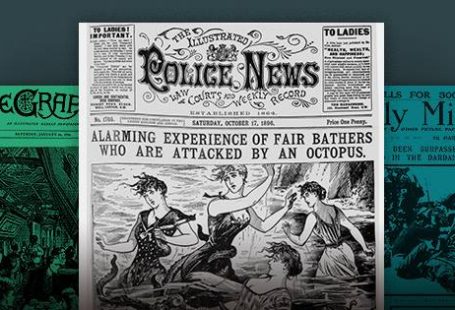‘Disliking urban surroundings,’ Jane Austen ‘relied on the English countryside for her own happiness and for the background of her novels,’ so writes Wendy Hope in a 1975 Illustrated London News article. In this special blog, using pages taken from the British Newspaper Archive, we will explore the locations where celebrated novelist Jane Austen lived, wrote, and visited, and how they informed her novels.
Want to learn more? Register now and explore The Archive
Illustrated London News | 1 December 1975
Bath – ‘A Determined Disinclination’
Jane Austen spent her early life at the Rectory in Steventon, Hampshire, where she drafted Pride and Prejudice and Sense and Sensibility, and wrote Northanger Abbey. But in 1801 her father the Reverend George Austen retired, and he, Mrs Austen, Jane and her sister Cassandra removed to Bath.
A view of eighteenth century Bath | Illustrated London News | 1 December 1975
But Bath was not to be a happy place for Austen, and she did not write any novels there. Indeed, this same unhappiness is reflected in Anne Elliot’s experience of Bath in Persuasion. She is sure she will not enjoy it, and as Wendy Hope observes:
Like Anne Elliot, she ‘persisted in a very determined disinclination to Bath.’ [Austen] had missed the country, but there were other reasons: the presence of an unlikable uncle and aunt, and the tragic end of her only serious love affair, which occurred during the Bath years.
It seems Austen felt restricted by her urban surroundings, and as the Irish Independent elaborates, another reason that she didn’t like Bath was because ‘it lacked a park.’ But during the Bath years Austen was to visit Lyme Regis, a place which she wrote much more favourably about, and it would become the backdrop to one of the most famous scenes in nineteenth century literature.
Lyme Regis – ‘Old Wonders and New Improvements’
‘Don’t talk to me of the Duke of Monmouth,’ he exclaimed. ‘Show me the exact spot where Louisa Musgrove fell!’ So demanded Alfred Lord Tennyson as he arrived in Lyme Regis, Dorset. He had been invited to view the beach where the Duke of Monmouth landed in his failed attempt at rebellion, but he was much more interested in tracing the fictional footsteps of Persuasion’s Louisa Musgrove, who, on a visit to Lyme Regis, falls from the Cobb and subsequently falls for a new suitor.
 Lyme Regis in 1796 | Illustrated London News | 1 December 1975
Lyme Regis in 1796 | Illustrated London News | 1 December 1975
The Bristol Times and Mirror in 1909 tells of how Jane Austen went with her mother and father to visit Lyme Regis in 1804, whilst she was living in Bath. After her chaffing at the vanities of urban Bath, coastal Lyme Regis was very much a breath of fresh air, as she wrote:
…the walk to Cobb, skirting round the pleasant little bay, which, in the season, is animated with bathing machines and company; the Cobb itself, its old wonders and new emprovements, with the very beautiful line of cliffs, stretching out to the east of the town, are what the stranger’s eye will seek, and a very strange stranger it must be who does not see charms in the immediate environs of Lyme, to make him wish to know it better.
Austen knew a rare sense of liberty in the Dorset town, and enjoyed bathing there, staying in ‘rather too long.’
A storm strikes Lyme Regis | The Sphere | 19 August 1933
But is it possible to trace Austen’s steps in the town? The Bristol Times and Mirror relays the experiences of one Captain Boteler, who came to the town in 1827. There, proud locals pointed out the cottage where she was meant to have stayed, and the other cottage which inspired Captain Harville’s abode.
Chawton – ‘A Place of Pilgrimage’
Austen, her mother and sister, finally settled in Chawton, Hampshire, after the death of her father. The house in which they lodged was formerly a pub, and it was near the large house of her brother Edward, who had been adopted by the Knight family and had changed his name accordingly.
The Cottage at Chawton | The Sphere | 4 January 1947
Once back in the countryside, Austen found her muse again, and her writings were prolific as they were to be celebrated. The Sphere in 1947 tells of how:
It was at Chawton that Jane rewrote her first novel from the draft called ‘Eleanor and Marianne,’ and published it as ‘Sense and Sensibility’ in 1811… Here her next work, ‘First Impressions,’ was rewritten and published as ‘Pride and Prejudice,’ in 1813, ‘Mansfield Park,’ published in 1814, ‘Emma,’ published in 1816, and ‘Persuasion’, published after her death, were all written during her time in this house, which was therefore the home of all her works, except ‘Northanger Abbey’…in the form in which we know today.
But Austen was keen to keep her writing private. The Illustrated London News in 1946 tells of the ‘famous creaking door,’ which warned the writer of approaching ‘intruders,’ allowing her to hide her manuscripts away from prying eyes.
Illustrated London News | 28 December 1946
Steventon Rectory, Jane Austen’s birthplace, was pulled down soon after her death, in 1826. Therefore, fans of the novelist in the twentieth century sought for some site of pilgrimage, as the Illustrated London News explains:
However certain of an author’s immortality, most readers are conscious of the need of a shrine of some sort, a place of pilgrimage, full of memories and memorials. Just such an opportunity has arisen for the lovers of Jane Austen.
This opportunity was the cottage at Chawton, which remained standing in 1946. In January of that year, The Sphere relates how the Jane Austen Society was ‘seeking to acquire and preserve’ it for the sum of £5000. Although divided into flats and occupied by three different families, it remained much ‘as it was during Jane’s lifetime.’
The Cottage at Chawton | The Sphere | 30 July 1949
In the end, ‘the celebrated cottage at Chawton’ was bought by one Mr T Edward Carpenter of Mill Hill, who ‘presented it to the nation in memory of his son, Lieutenant Philip John Carpenter.’
The Sphere reports in July 1949 that the cottage was opened as the Jane Austen Museum by the Duke of Wellington, president of the Jane Austen Society. The museum was somewhat of a work in progress – based in the one room, the drawing room, it had ‘yet few of Jane Austen’s possessions. Among the treasures there are two silk purses, a kerchief which Jane embroidered, her oak desk, and a piece of doggerel she wrote on having a pain in the head.’
The museum at Chawton | The Sphere | 30 July 1949
This small scale museum was a necessity at the time, however, as the Illustrated London News explains:
It is not proposed, in the present housing shortage, to dispossess the present inhabitants, but the big drawing-room is immediately available, and it is proposed here to form the nucleus of a collection of relics and a place of pilgrimage in which the spirit and personality of England’s greatest woman novelist shall be crystallised for all her devotees – the place in which she observed life so brilliantly and recorded it with such precision and strength.
Winchester – The End
After enjoying many prolific years at Chawton, where the house remains as a site of pilgrimage for Austen fans across the globe, Austen began to fall ill. She then removed to Winchester, where she could be more easily treated by her surgeon.
Her lodgings were on College Street, today marked by a plaque, with a ‘neat little drawing-room.’ Those were her own words, and even whilst ill, she continued to write. However, hers was to be a losing battle, and she passed away aged 41 on 18 July 1817. She was buried at Winchester Cathedral.
We are lucky today to be able to visit the locations which inspired the great novelist, and fortunate to have newspapers as a useful resource in helping us uncover the connection between Austen and her scenery. We also have wonderful contemporary reports of her novels, which you can explore in this blog, and you can also search the pages of The Archive yourself, for more on Austen and other famous writers, as well as much more besides.














